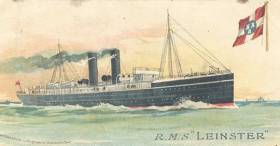Displaying items by tag: Salute Kish Wreck Site
Ferry From Holyhead Wales to Pay Salute to Victims of RMS Leinster off Kish Bank Wreck Site
#rmsLeinster - Originally a Stena Line ferry sailing from Holyhead, Wales was to make a diversion in Dublin Bay involving a sail-past off Dun Laoghaire Harbour to mark tomorrow's centenary anniversary of the sinking of RMS Leinster, writes Jehan Ashmore.
As part of numerous events in the run up and for tomorrow's anniversary, the Mail-Boat Leinster Centenary Committee had planned to have a Stena ferry off Dun Laoghaire blast it's horn five times in memory of the more than 500 victims of RMS Leinster. The steamer having departed Kingstown (Dun Laoghaire) was lost to enemy action by a German U-Boat in the closing weeks of World War One. Church bells will ring out in Dun Laoghaire to mark the time of when RMS Leinster was struck by torpedo. On the Welsh side of the Irish Sea, events to mark the historic tragic event will too take place in Holyhead, Anglesey
Afloat first noted of the planned ferry related event with intrigue, having consulted the Comittee's Centenary Events yellow brochure. According to the Committee, Stena were unable to divert the ferry off Dun Laoghaire Harbour but instead will pass the Kish Bank to pay a salute close to the wreck site. The wreck site based on research from INFOMAR has the location of the RMS Leinster as 19km ESE of Howth Peninsula.
The ferry related event is to take place later tomorrow morning, following the main official state centenary commemorative ceremony when a flotilla departs Dun Laoghaire Harbour at 07.00. Appropriately, families to those related on board will lead the flotilla on board St.Bridget. The excursion vessel is to be escorted by the local RNLI lifeboat and finally the Irish Naval Service LE Orla. The wreath-laying event is to take place at the wreck site at 07.45hrs.
As previously reported was the role of the Irish Coastguard helicopter which can now be confirmed in attending the ceremony at sea. The helicopter is due to depart its base in Dublin Airport and meet the flolilla at 07:45. Upon conclusion of proceedings the flotilla are to return to Dun Laoghaire Harbour at around 09.00.
Based from these times, this would be too early for the Stena ferry to take part having identified the sailing departing Holyhead at 08.55. Afloat has also identified the ferry as the Stena Superfast X which is to arrive in Dublin Port at 12.10.
Among the flotilla is the Dublin Bay excursion vessel St.Bridget, chartered out by the Committee (see story) to bring families related to those lost from the City of Dublin Steam Packet steamer RMS Leinster. The Royal Mail Steamer (RMS) given its prefix to the ship's name was due to the steam packet company having a contract from the Royal Mail to carry mails and parcels across the Irish Sea which involved mail-trains in Holyhead and notably connecting Dublin and London.
Likewise of RMS Leinster, the Stena ferry takes a route between Ireland and Wales that routinely involves the Kish Bank which 100 years ago had a lightship. In 1965 a revolutionary fixed lighthouse structure replaced the bygone era of the stationed floating light ship.
























































